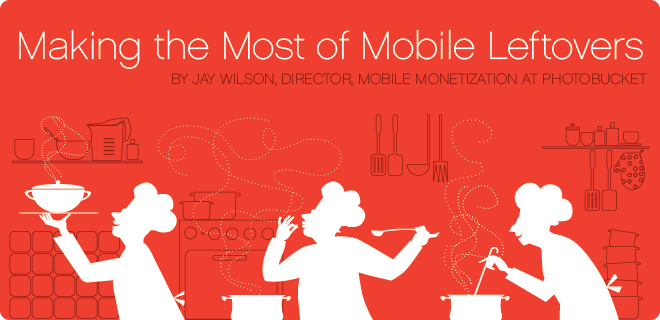
I recently began reading a novel by Tom Perrotta called The Leftovers that imagines a suburban US neighborhood post-Rapture. One of the religious sects that emerges in the novel is named the Guilty Remnant. It isn’t often I read a novel that reminds me of my job managing yield for mobile ad networks, but the words “guilty” and “remnant” coupled so closely had me thinking of the way that executives across the industry consider remnant inventory to be undesirable. The conventional thinking is that remnant inventory is of little significance because of low price points and ad content of questionable quality. As a result, the topic of optimizing yield on mobile properties is sorely neglected.
Here is a brief state of the union: Supply is vastly outpacing demand (queue a Mary Meeker slide, please). Price points are weaker than their display counterparts and mobile CPMs are on the decline as everyone prays that demand will pick up. But despite these seemingly grim conditions, there is promise for a very lucrative future. Where there is a nascent market, there is money to be made.
On top of these market conditions, mobile sell-through for small and large publishers alike is relatively low. I recently heard from a large agency buyer that purchasing for a typical mobile campaign allocates only 10% of the money appropriated for direct buys on a handful of relevant or premium sites; the remainder is sent to networks for larger-reach buys. With 90% of the mobile money bucketed in the hands of networks, it only makes sense that an investment needs to be made to help guarantee that publishers are extracting as much value as possible from those campaigns.
Secondary sales channels (namely networks and exchanges) are frequently how publishers produce the majority of mobile ad revenue. Unfortunately, many of these publishers lack the time, resources, or interest to devote toward the task of managing yield in their mobile environment. Given that a publisher possesses a large enough quantity of impressions, it is a huge mistake to not see the potential ROI in optimizing the remnant channels.
What options do publishers have? They can bring on a “mobile guy” to help create a decision-model for yield optimization, trust their mediation layer to optimize correctly, or turn to a single network partner or SSP. I’ve seen all three of these situations play out. I’m far from unbiased, but only one scenario seems to really work.
Let’s start with the yield optimization algorithms present in most mediation layers. The technology works most of the time. But it only works well when the information (impressions, clicks, and revenue) comes in accurately. I’ve seen revenue in mediation layers “stated” in every way possible: under-stated, over-stated, not stated, and sometimes correctly stated. Given the nature of integrating two divergent systems (networks and mediation), solely trusting an algorithmic optimization engine with imperfect information will not give you the yield results you seek. Furthermore, any sort of complex setup is going to cause difficulties for these engines.
That brings us to SSPs; old guard supply platforms (perhaps) did well on display, but, in my humble opinion, all are doing a sub-par job with mobile. Sure, algorithmic optimization from a mediation layer or an SSP holds a place in the toolkit of any publisher. Can an SSP effectively navigate the markets and understand trends and relationships? Can they parse out the nuances in performance of every publisher’s traffic? Are these services offering adequate diversity of demand sources? Can these systems effectively find and exploit inefficiencies?
It truly takes a combination of these factors to successfully monetize mobile properties. A successful company has good people manning the technology and partnerships with the right tools in-house, knowledgeable and reliable technology vendors, and a slew of network and exchange partners to help create a diversified ad revenue portfolio.
Mobile brings us into an even more complicated advertising environment. We have new concepts of what an ad can do and where it is seen, new mediation technology and demand partners, as well as new targeting parameters and data. While the big web brought a relatively frictionless ad serving ecosystem, a whole set of issues emerged with mobile. Working with the leftovers is crucial for any publisher that sees the near future as mobile-centric.